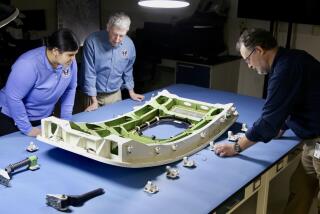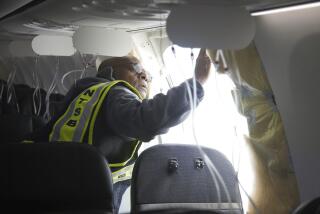Key Portions of TWA Jetâs Center Are Recovered
SMITHTOWN, N.Y. â Appearing confident that they are moving closer to answering why TWA Flight 800 fell from the sky, federal officials said Friday that they have recovered key sections from the center of the plane that could help them determine whether the jumbo jet malfunctioned or was blown up.
Those center sections--a large piece of the middle fuel tank, the roof over some of the middle passenger seats and some of the seats themselves--show extensive fire and burn damage, authorities said.
They come from a forward portion of the middle section of the Boeing 747--the spot where officials believe Flight 800 broke apart because of a large explosion.
In addition, officials said, they have recovered all four of the aircraftâs engines and that none show signs of a major blast--a finding that undercuts the theory that a heat-seeking missile was fired at the plane.
The announcements Friday appeared to bolster the spirits of officials from the FBI and the National Transportation Safety Board.
In recent days, investigators have seemed exasperated at the slow pace of wreckage recovery and they were cautioning that the investigation could wear on weeks longer.
James K. Kallstrom, an assistant FBI director who is leading the criminal review into the July 17 disaster, brushed aside growing speculation that investigators may not be able to determine conclusively whether the plane was brought down by sabotage.
*
âI really still firmly believe--and I am optimistic--that we will find the cause of this disaster,â he said.
The center section of the plane became the area of most interest for investigators after other parts of the plane--including the cockpit, the front cargo hold and the front galley section--were recovered and showed no evidence of a bomb or mechanical failure.
Those sections were from the front part of the plane, which broke off and fell separately to the ocean floor after the jet exploded at more than 13,000 feet above the Long Island coastline.
Moving from front to rear in examining the aircraft, the experts now are focusing on the area where the wings joined the fuselage--along the middle of the passenger cabin, particularly between seat rows 17 through 28.
Robert Francis, NTSB vice chairman, said that a newly found large side section of the center fuel tank is âvery interesting to us.â
âHopefully this will tell us what we would like to know,â he said.
Francis declined to elaborate but said that other pieces of the tank still must be pulled from the water.
The tank was carrying less than 100 gallons of jet fuel and officials have theorized that, with the fuel sloshing around in the tank, it could have created vapors that would be susceptible to a fire.
Francis described the seats as having been located above the tank, the area where the fireball most likely erupted on the plane after the explosion.
âThatâs the area that is closest to the fuel tank area,â Francis said.
âThat area is consistent with where we are finding most of the fire. There are more seats burned there than we are finding elsewhere.â
Francis said that initial examinations of the four engines provided no clues to what happened. âI think itâs fair to say that thereâs nothing really extraordinary that we have found as of yet,â he said.
He added that some of the experts examining the engines worked on other air disasters, including the bombing of Pan Am Flight 103 over Lockerbie, Scotland, in 1988.
âAnd they up to now are not seeing anything that they would consider exceptional,â Francis said.
*
The fact that the planeâs engines appear generally intact, except for broken fan blades, does not automatically discount the possibility that a heat-seeking missile hit one of them, Kallstrom said.
âThe missile theory is still on the board,â he said. âThat doesnât take it off the board.â
He said there are different kinds of missiles, including some that explode just before hitting a target. âTheoretically, that could have happened here,â he said.
Also on Friday, officials said that they now have recovered 204 of the bodies of the 230 passengers and crew members who died on the flight.
More to Read
Sign up for Essential California
The most important California stories and recommendations in your inbox every morning.
You may occasionally receive promotional content from the Los Angeles Times.











